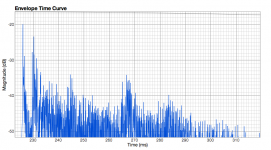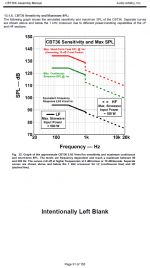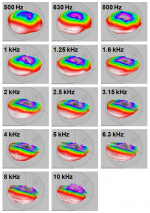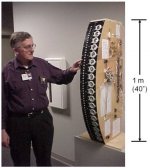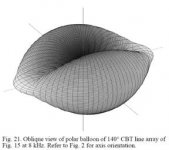Omholt,
That would depend completely on the size of the waveguide, I have seen them as big as 8 meters across. So it is an open question of mouth size and length.
That would depend completely on the size of the waveguide, I have seen them as big as 8 meters across. So it is an open question of mouth size and length.
Wasn't Avant Garde, was it? 😛"Well those are good examples of what gives horns a bad reputation!"
Tom, thanks for your post. It got me to thinking about the Smyth Realizer headphone gadget. According to the reviews, it really hides the location of the speaker. I.E., you can't tell that your wearing headphones. That might be the biggest speaker disappearing act of all.
When I get caught up on current project, I plan to make a DIY Smyth device to see if I can get the same sort of effects.
OT, one of your sales reps is coming by the office on Tues to demo some gear. Alas, I will not be at the shop that day, but out on a gig.
The focus here is on the speakers solely, their configuration and setup, to achieve this "effect". And I'm sure that clever alignment of the drivers and the room will aid it happening. However, it's not the only way, system integrity is key, which means that the whole shebang is of sufficient quality.
So, brilliant speaker setup, and everyday electronics may do it. Or, extremely well sorted out earlier chain and average, ordinary speakers can also make it happen.
My first "success" was with B&W DM10s, can't get more "vin ordinaire" than this ...
Speaking of the MBLs, I gave the audio game away for a decade or so because it was so frustrating trying to get the "magic" to happen consistently. An audio show in Sydney, extremely well setup MBLs, inspired me to give it another go ... 🙂
I've noted that there are at least 2 ways people listen to speakers: some like the airiness and sense of space that well sorted systems and omni speakers create; others tune into the sound coming at you with your head locked into a vice type of thing -- so there will always be some disagreement on what's right ...
Frank
So, brilliant speaker setup, and everyday electronics may do it. Or, extremely well sorted out earlier chain and average, ordinary speakers can also make it happen.
My first "success" was with B&W DM10s, can't get more "vin ordinaire" than this ...
Speaking of the MBLs, I gave the audio game away for a decade or so because it was so frustrating trying to get the "magic" to happen consistently. An audio show in Sydney, extremely well setup MBLs, inspired me to give it another go ... 🙂
I've noted that there are at least 2 ways people listen to speakers: some like the airiness and sense of space that well sorted systems and omni speakers create; others tune into the sound coming at you with your head locked into a vice type of thing -- so there will always be some disagreement on what's right ...
Frank
Speaking of the MBLs, I gave the audio game away for a decade or so because it was so frustrating trying to get the "magic" to happen consistently. An audio show in Sydney, extremely well setup MBLs, inspired me to give it another go ... 🙂
Frank
Frank, that is also what I understood SY's impression of the MBL's were; another pair of trusted ears. Omni's aren't out yet.
I actually think that the MBL's are a very interesting implementation of almost a pulsating sphere. The concept alone was fairly brilliant, what they sound like is another story but you can't fault the technical thinking that went into the design. And I said what they sound like because I have never heard them, but I would like to in a proper setup!
How far do you set them in the hall, and how few microphones do you use?
It really depends on the hall's acoustics, and how much of the hall's acoustics I want to blend with the actual orchestra. The better the hall's sound, the fewer microphones I use. Sometimes it can be nothing more than a Decca tree setup and two spaced omni's.
It also depends on the music, and the size of the orchestra I am recording.
If you do recording right, pre-production preparation is essential, and can take months.
Anyway, when I fired the first of Roys ESL’s back up in my listening room, that is when I was struck by the way some sound / recordings seemed to come from behind the speaker. It made me wonder why and I thought it had to be the way the speaker radiated, not how it worked.
Tom,
The only time I get a sensation of depth is when reflections from other locations than the speaker are present.
I've tried all sorts of speakers with very different directivity. High directivity speakers in low reflection environments always create a very narrow, pin-point stage without any depth. The higher the directivity, the closer the sound stage. The closest image came from a 8" full range driver. It was floating in front of the speaker plane, with phantom sources only an arm's length away.
Certain reflection patterns add a sense of real depth.
It all started by placing a second pair of speakers at ±60° fed by the stereo signal. It added spaciousness and depth.
Then I tried pointing speakers to the side wall and it had the same effect. I could create that sensation with nearly all types of speakers. Even the 8" full range speaker will perform like this if the speakers are toed-out.
This is how I listen today, Geddes Nathans toed-out. This creates a huge stage with depth while localization is still very good.
Interesting observation - when the contra-lateral reflection is absorbed, a huge amount of depth is gone. This somewhat baffled my because the level of this reflection is way down.
Last edited:
This is how I listen today, Geddes Nathans toed-out. This creates a huge stage with depth while localization is still very good.
Most interesting. Having built the econowaves I did try extreme toe-in as presrcibed by many. But found out that normal triangle works best. I thought it was because econowave does not have that frequency response dip. But never tried a 'toe-out'. Will do !
Most interesting. Having built the econowaves I did try extreme toe-in as presrcibed by many. But found out that normal triangle works best. I thought it was because econowave does not have that frequency response dip. But never tried a 'toe-out'. Will do !
You'll need to equalize the response though.
Experiment with the amount of toe-out too.
Here's a chart that shows the sensitivity and SPL of CBT36. It get's lower in the treble. I believe this is sufficient for most homes. I don't experience any straining as Pano mentioned.
The new CBT36XL will obvioulsy be able to play much louder.
Also attached polar of a smaller prototype as well as a figure that shows the horizontal dispersion. Seems like some missed that earlier. I cannot speak for the Monte Kay's laying CBT center and his mesasurements, but this is what Don Keele has measured.
I hope Don will soon be able to publish polars of the CBT36 and CBT36XL which will have controlled directivity lower in frequency then the prototype.
The new CBT36XL will obvioulsy be able to play much louder.
Also attached polar of a smaller prototype as well as a figure that shows the horizontal dispersion. Seems like some missed that earlier. I cannot speak for the Monte Kay's laying CBT center and his mesasurements, but this is what Don Keele has measured.
I hope Don will soon be able to publish polars of the CBT36 and CBT36XL which will have controlled directivity lower in frequency then the prototype.
Attachments
Last edited:
Interesting observation - when the contra-lateral reflection is absorbed, a huge amount of depth is gone. This somewhat baffled my because the level of this reflection is way down.
How did you achieve this without also absorbing the ipsilateral reflection from the principal speaker ? Don't they originate from almost the same location on the wall.
I've tried all sorts of speakers with very different directivity. High directivity speakers in low reflection environments always create a very narrow, pin-point stage without any depth. The higher the directivity, the closer the sound stage. The closest image came from a 8" full range driver. It was floating in front of the speaker plane, with phantom sources only an arm's length away.
This is exactly my experience as well. Note that this is the effect of frequencies above about 1kHz. Speakers having high directivity in this freq range aimed towards the listener creates very unnatural auditory scenes.
Certain reflection patterns add a sense of real depth.
It all started by placing a second pair of speakers at ±60° fed by the stereo signal. It added spaciousness and depth.
Then I tried pointing speakers to the side wall and it had the same effect. I could create that sensation with nearly all types of speakers. Even the 8" full range speaker will perform like this if the speakers are toed-out.
Have you tried this simple configuration of adding extra speakers ? The extra speakers are at about 55 deg, which according to Ando creates small IACC which is preferable.
G = gauche
D = droit
An externally hosted image should be here but it was not working when we last tested it.
- Elias
How did you achieve this without also absorbing the ipsilateral reflection from the principal speaker ? Don't they originate from almost the same location on the wall.
They are about 80cm apart.
I was wondering if anyone here wanted to do some testing. I could easily make some test tones. If we can figure out what's needed (that can evolve, if necessary) then I'm happy to make the tones and post them here. Or better yet, in a new thread.
I tried this today without any results.. 🙁
Time intensity trading | Auditory Neuroscience
I just switched the tweeter on/off but I don't think the test tone freq goes high enough.
I heard MBL 101. A few years ago, so don't know if it was the MKII version or an earlier one.
There's definetly something wrong with the concept if you want accuracy and a precise image in a small bounded space. And that's very understandable from what we know about acoustics. I'm not arguing about other preferences.
In terms of still hearing the direct signal you're right, but high gain specular energy still greatly has an effect on the sound quality. There's a difference there.
I think the problem with omni's bad rep comes with the way they are used. My limited experience makes me think you want to place them far, veeeeery far from boundaries, they can then sound gorgeous, it implies huge rooms for a big system like MBL.
If not, yes, huge sound from the reflexions, some like it and some don't.
The other solution is to create loudspeakers that act as a point source, like the MBL's. This way, it is possible to have a very wide sweet spot, basically filling most of the room. Linkwitz's Pluto goes some way towards this.
or Watkinson's beautiful Cabar. Never seen or heard one. 🙁🙁
Earl,
How low in frequency would a 18" waveguide have controlled directivity to?
The width (if thats what you mean) of a waveguiode is a little ambiguous if it has a mouth flare as all of mine do. The Summa waveguide is 18" in diameter with the mouth flare, but only 15" if you consider where it would terminate in the baffle without the flare. It does well down to about 1 kHz, so an 18" might go down to 800 Hz.
Last edited:
The new CBT36XL will obvioulsy be able to play much louder.
Since the XL has the same tweeters and the MaxSPL limit is due to the tweeters, I don't think that it will have more MaxSPL.
- Home
- Loudspeakers
- Multi-Way
- Linkwitz Orions beaten by Behringer.... what!!?
